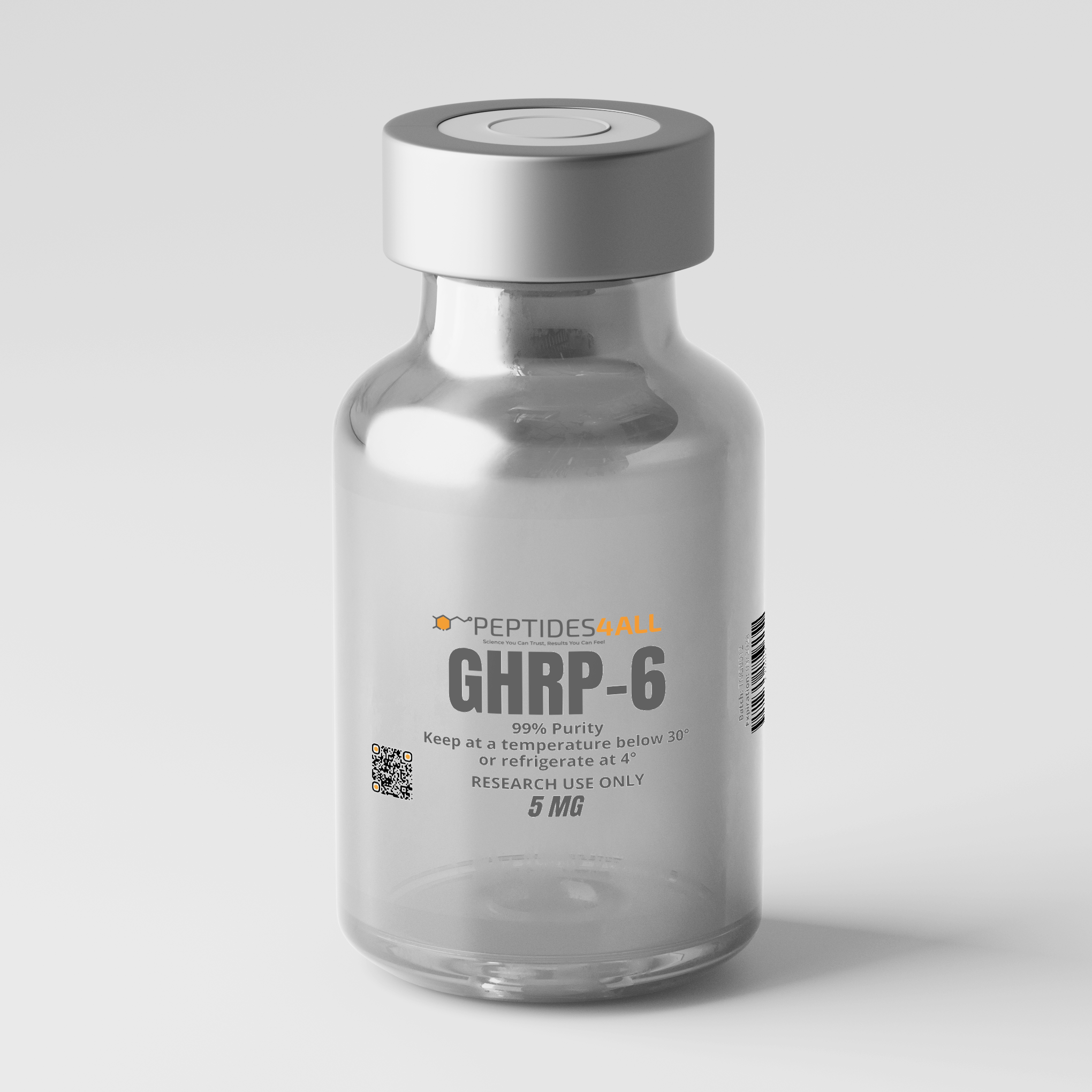PEPTIDES4ALL GHRP-6 (Growth Hormone Releasing Peptide-6) – GH Secretagogue & Regenerative Research Peptide
PEPTIDES4ALL GHRP-6 is a synthetic hexapeptide belonging to the class of growth hormone secretagogues (GHS)—a family of compounds that activate natural growth hormone (GH) release through the ghrelin receptor (GHSR-1a). Developed in the early generation of GH secretagogues, GHRP-6 remains one of the most widely studied and biologically versatile peptides in endocrine and regenerative science.
By mimicking endogenous ghrelin signaling, GHRP-6 stimulates pulsatile GH secretion from the anterior pituitary, reproducing a physiologic release pattern rather than continuous stimulation. This dual-pathway mechanism—independent yet synergistic with growth hormone–releasing hormone (GHRH)—makes it an ideal model for studying metabolic regulation, tissue repair, and cellular growth pathways.
Beyond its established GH-promoting effects, emerging research has broadened GHRP-6’s scientific relevance into fields such as cardioprotection, neuroprotection, and organ regeneration. Studies have demonstrated its ability to reduce cardiac fibrosis, preserve myocardial function, and enhance tissue recovery following injury or oxidative stress. Additionally, its anti-inflammatory and cytoprotective properties are of growing interest in investigations involving aging, muscle wasting (cachexia), and metabolic disorders.
Because of its well-defined pharmacokinetic profile and reproducible biological response, PEPTIDES4ALL GHRP-6 serves as a reliable and high-purity research tool for exploring the interconnected pathways of growth hormone regulation, cellular repair, and metabolic homeostasis, contributing to ongoing advances in endocrine physiology and regenerative medicine.
Scientific Evidence & Research Findings
-
Potent GH Release – GHRP-6 stimulates growth hormone secretion through ghrelin receptor activation, even without GHRH. This dual pathway produces stronger and more flexible GH pulses, supporting studies in growth, metabolism, and recovery. https://academic.oup.com/jcem/article-abstract/83/4/1186/2865313
-
Anabolic & Regenerative Support – Research suggests GHRP-6 enhances lean body mass, improves appetite, and promotes tissue resilience, making it valuable in cachexia (muscle-wasting) and metabolic health models. https://pmc.ncbi.nlm.nih.gov/articles/PMC5632578/
-
Cardioprotective & Anti-Fibrotic Effects – In animal studies, GHRP-6 reduced heart fibrosis, preserved cardiac function, and limited damage under chemotherapy-induced toxicity, indicating potential in cardioprotection and organ repair research. https://www.frontiersin.org/journals/pharmacology/articles/10.3389/fphar.2024.1402138/full
-
Metabolic Regulation – By modulating GH and appetite pathways, GHRP-6 may influence fat metabolism, energy balance, and adaptation to metabolic stress.
-
Neuroprotective Potential – GH stimulation and ghrelin receptor signaling have been linked to improved neuronal function and resilience, offering potential in neurodegenerative or stress-related research models.
Key Research Benefits & Applications
-
Physiological GH Pulse Simulation: Promotes pulsatile growth hormone secretion via ghrelin receptor (GHSR-1a) activation, closely replicating natural circadian GH rhythms rather than continuous release.
-
Dual-Pathway Synergy with GHRH: Functions independently yet synergistically with GHRH analogues (e.g., CJC-1295 or MOD-GRF 1-29), producing enhanced GH pulses and a more physiologic endocrine response in experimental models.
-
Anabolic & Regenerative Support: Stimulates muscle growth, tissue repair, and cellular recovery, making it ideal for studies in cachexia, muscle atrophy, and metabolic adaptation under stress.
-
Cardioprotective & Anti-Fibrotic Activity: Demonstrates reduced myocardial fibrosis, improved cardiac function, and cytoprotective effects in models of cardiac injury and oxidative stress.
-
Neuroprotective & Cognitive Effects: Ghrelin receptor signaling contributes to neuronal survival, neuroplasticity, and protection against ischemic or degenerative insults.
-
Metabolic Modulation: Regulates energy balance, appetite, and lipid metabolism, offering a research model for exploring GH-linked metabolic pathways and homeostatic control.
-
Applications in Endocrine & Regenerative Research: Serves as a validated tool for investigating GH axis modulation, organ repair mechanisms, and systemic recovery processes within endocrine and metabolic frameworks.
Presentation & Handling
- Form: Supplied as lyophilized peptide in sterile vial.
- Reconstitution: Use bacteriostatic water or 2% procaine; swirl gently (do not shake vigorously).
- Storage: Store at –20 °C, protected from light and moisture. After reconstitution, use according to research protocols and handle under sterile conditions.
Intended Use
For research purposes only. Must be handled in accordance with institutional protocols and ethical guidelines.
